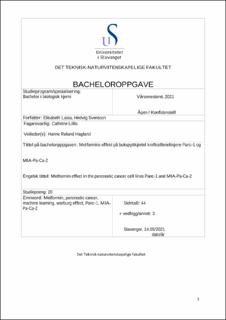| dc.description.abstract | This collaboration bachelor thesis focuses on cancer and how the drug metformin might be a future cancer treatment as it interrupt the cells metabolism by inhibition of complex I of the respiratory chain and numerous studies have shown that it affect cancer cells in many beneficial ways.
There are numerous publications available regarding metformin effect in cancer cells, and part of our bachelor thesis involved extracting data from 66 scientific articles where metformin was used and cells were tested for viability, oxygen consumption rates (OCR) and extracellular acidification rates (ECAR) and more, which we organized in a database. The database now includes information of which glucose concentration was used in cell growth media, metformin concentration, which cell lines were used, viability before and after metformin treatment, treatment time and the results of the XF seahorse analyzer; OCR and ECAR which are measurements of cell metabolism.
The aim was to use these data to create a model, using machine learning, that could predict cell how different cells would respond to metformin (viability) based on their metabolic data. Furthermore, we used two pancreatic cancer cell lines, Panc-1 and MIA-Pa-Ca-2 in lab experiments to test their sensitivity to metformin treatment using two different cell viability assays.
The two different pancreatic cancer cell lines, Panc-1 and MIA-Pa-Ca-2 was exposed to the biguanide drug metformin in three different concentrations. To be within the sensitivity of the assay, three cell viability assays was done in advance of the metformin experiment and showed that 10 000 cell/well was the best option. Both cell lines were seeded out as 10 000 cell/well on a 96-well plate before exposure to metformin. The cells were treated with three different metformin concentrations, 1 mM, 5 mM and 10 mM respectively, and incubated for 24 hours and 48 hours.
The results from the metformin treatment of the two cell lines showed that metformin does affect the cells as the cell viability decreased when the metformin concentration increased. The cells that was treated for 24 hours had much higher viability than those treated for 48 hours, so the most efficient treatment time was 48 hours. There were some deviations, especially for the Panc-1 cell line, but this was most likely due to errors done when preparing the plates. The MIA-Pa-Ca-2 cell line seemed to be more affected by 48 hours metformin treatment than Panc-1 cells, but the Panc-1 cells were more affected by 24 hours metformin treatment compared to MIA-Pa-Ca-2 cells based on results from this experiment.
The machine learning part was not very successful as the model did not give good predictions compared to the result. These results might have been different if done by someone with more experience. Machine learning have great protentional for medical research. | |
